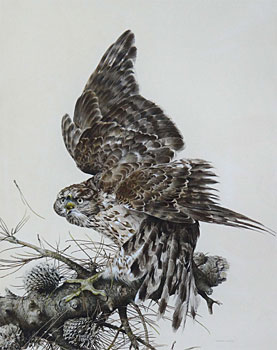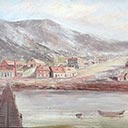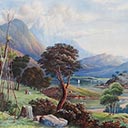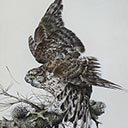Goshawk
71.2 x 55 cm
est. $15,000 - 20,000
Provenance: Private Collection, Queensland
Private Collection, Northland
Exhibited:
International Art Centre 1980
Illustrated: p. 59 Raymond Ching The Bird Paintings, Text by David Snow, A H Chisholm & M F Soper, William Collins Sons & Company Limited 1978
Among the diurnal birds of prey two groups far outnumber all others in the number of species: the typical falcons, with long pointed wings, placed in the genus Falco; and the hawks of the genus Accipiter, with relatively shorter and more rounded wings. The Goshawk is the largest and most powerful member of the latter group. It is a northern species, distributed across the whole of Eurasia and North America, south in the Old World to the Mediterranean area and the Caucasus, and in the New World to northern Mexico.
Whereas falcons hunt their prey in the open, the accipitrine hawks are adapted for hunting in woodland, their broad wings and rather long tails enabling them to twist and turn among the trees with great agility. This is the Goshawk's method, and for its size - its length is about two feet and its wing span nearly four feet - it is remarkably manoeuvrable. It takes birds and mammals of many kinds, up to about its own size. Often it ends its attack, if its quarry is on the ground, with a long straight glide at very high speed. Its legs and feet are exceptionally powerful and the prey, once seized, is quickly crushed to death.
Goshawks are most numerous in the extensive coniferous forests of the taiga zone but occur also in mixed woodlands. Persecution by man and destruction of the forests have reduced their numbers in many areas. But where man tolerates them they can survive in close proximity to him, as long as enough woodland remains. They are in some demand by falconers, for though they are not easy birds to train or handle they rival the largest falcons in their ability to kill large game-birds and can take mammals up to the size of hares.
The Goshawk's bulky stick nest is placed usually at a fair height in a tree, and may be added to from year to year. The clutch is usually three to five eggs which hatch after about thirty-seven days. The young fly at the age of about forty-five days, and if they survive the dangerous early period of heavy mortality, they may live long; individual ringed birds are known to have lived for at least twenty years.
David Soper
Raymond Ching The Bird Paintings
William Collins Sons & Company Limited 1978





